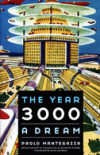The Year 3000: A Dream
Clean energy, universal healthcare, and stress-free air travel are reality. There is no crime or homelessness. The universal language is called Cosmic. Political parties are banished to desert islands. Hamlet is still performed. All this and more is the world Italian anthropologist Paolo Mantegazza creates in The Year 3000: A Dream. Translated into English for the first time as part of The University of Nebraska’s “Bison Frontiers of the Imagination Series,” this entertaining 1897 novel has been rescued from the black hole of book oblivion.
Clean energy, universal healthcare, and stress-free air travel are reality. There is no crime or homelessness. The universal language is called Cosmic. Political parties are banished to desert islands. Hamlet is still performed. All this and more is the world Italian anthropologist Paolo Mantegazza creates in The Year 3000: A Dream. Translated into English for the first time as part of The University of Nebraska’s “Bison Frontiers of the Imagination Series,” this entertaining 1897 novel has been rescued from the black hole of book oblivion.
Mantegazza presents his future in the form of a travelogue. This easygoing approach presents the “cosmic civilization” of the United Planetary States as accepted fact or through the eyes of the characters. There is no brainwashing of the populace (though mindreading is imminent), drug-induced consciousness, or deviants seeking revolution. Everyone is happy. The lack of inferred commentary might surprise readers of Huxley, Orwell, and Zamyatin, but it is refreshing.
However—as in any utopia—there is unsettling business. The Year 3000’s travelers are the inventor Paolo and his fiancée Maria. They love each other and the world they live in. The pair is making their way in a private aircraft (part of everyday life!) from Rome eastward towards the United Planetary States’ capital city of Andropolis to see if their “love match” now qualifies as a “mating match.” The Year 3000 is one where life is so cherished that parenthood is sanctified by the State. Perhaps readers of this era may not think this is such a bad idea with the abduction/recruitment of child soldiers, social workers and educators failing to recognize at-risk children, or children of the rich and famous achieving fashion icon status. Paolo explains to Maria the basis of cosmic society:
A large assembly of sociologists and biologists buried socialism and founded the United Planetary States, governed by the best and more honest through a two-phase election. The government of dull-witted majorities was replaced by a government of knowledgeable, honest minorities. Nature’s aristocracy was copied by humankind, who made it the basis of human society. But, unfortunately we are still only halfway there. The art of choosing the best has not yet come; and men and women thinkers, the priests of thought and priestesses of feeling, still toil to find the best way, so that every man born to woman should have the rightful place nature accorded him at birth.
Later, the pair observes genetic testing on newborns to determine whether or not they are fit to live. As the doctor (now called a hygeian) explains, “Eliminating babies destined for suffering and premature death is the true act of pity.”
Besides guaranteeing the well-being of its citizens from birth, Paulo, Maria, and readers learn a great deal about four great concerns of cosmic civilization: agriculture, health, education, and industry fused with commerce. Religion still exists but “Hope” is the core belief. The couple and everyone they encounter know their world is not perfect and embrace innovation to make it better. Mantegazza wisely has an Engineer describe this fusion of faith and knowledge:
The Gospel of Christ was in its day a sacred work, a great battle won by universal justice, but in the twentieth century Edison’s school wrote another book on the applications of electricity that exerted a much more powerful influence on the morality of the future.
Hence, The Dream of the book’s title explained.
In addition to predicting the demise of socialism, the author has other interesting insights. A “great war” is prophesized eerily evoking both World Wars. One battle description could be mistaken for Gallipoli. Mantegazza envisions a powerful India, home of Andropolis. Today, this is a reality in industry and cinema but consider that The Year 3000 was written when India was part of the British Empire. In addition to private airplanes, other devices that make life in cosmic civilization easier include an “algophobus,” a sophisticated CAT scan machine, and an unnamed device for messaging that works “via telegraphic dispatches that were automatically written in luminous characters in a small black box kept in darkness.” Too bad smart phone users pour out onto the sidewalk in daylight.
Like Dante, Mantegazza loves all things Italian. Also like Dante, he cannot resist inserting himself in the text or poking fun at his contemporaries. His United Planetary States is noble and progressive, yet slightly biased. The author’s most glaring error in judgment is the prediction French Impressionism is a fluke:
At the end of the nineteenth century there came a period of great decadence, particularly in architecture and painting. At that time mediocre artists, too proud to copy antiquity and not knowing how to create any new form of beauty, lapsed into grotesquery.
By The Year 3000’s publication in 1897, Impressionism’s influence was permanent not only impacting painting but music, poetry, and drama as well. What is accurate is that the movement was both genuinely polarizing and revolutionary.
The Year 3000 is indeed an alternative universe where the world is a better place for all and true love is the most powerful force in the universe. Enjoy the trip.





